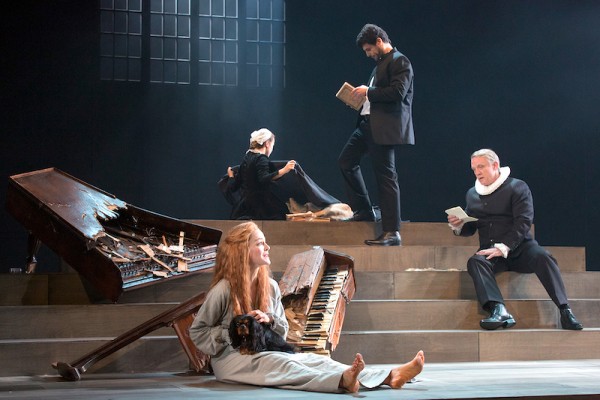Despite its title this play is about two queens. Two women, two brands of Christianity, and one crown. Scotland’s Mary Stuart and England’s Elizabeth Tudor were cousins, their paternal grandfather was Henry VII. The pursuit of power in Tudor times was a perilous business, as was the gaining of it. Henry VII managed to get himself on the throne, then consolidated his position by marrying Elizabeth of York, thus ending another – even bloodier – Cousins’ War, aka the War of the Roses. Now Elizabeth rules as the Virgin Queen, while Mary has been forced to abdicate the throne of Scotland and is under house arrest in England. In time, Elizabeth will have her executed, something that will haunt her – not only is she consigning a cousin to death, but in doing so she is calling into question the divine right of monarchs.
So much for history. What Kate Mulvaney has done here is extraordinary in that for the first time the play is focused on the feelings and interactions of the two women at its centre. Both were surrounded by men, politicking and pursuing personal and national advantages but, unlike Schiller’s original play, their roles have been sidelined and the two queens take centre stage. And brilliant they are too.
We meet Caroline Brazier’s Mary first. She is locked up in Fotheringhay Castle, under the care of Amias Paulet (Simon Burke). Mary, as befits a prisoner, is simply dressed, hair loose. She is now 44 years of age, but still spirited and a little coquettish and still petitioning for the chance to meet her ‘sister, friend and cousin, Prince Besse’. She has been a captive for 19 years.

Caroline Brazier, Darcey Wilson, Fayssal Bazzi and Simon Burke in STC’s Mary Stuart. Photo: Brett Boardman
By contrast Helen Thomson’s marvellously imperial and petulant Elizabeth is magnificently attired, sparkling and attended by sycophants, among them her long time (if platonic) love interest Dudley (Andrew McFarlane) and her all-important chief advisor, William Burghley (Tony Cogin), who is keen to talk up Papist plots. When it comes to scare campaigns and the politics of fear, plus ca change. It is left to Peter Carroll’s more circumspect Shrewsbury to be a calmer voice. As the simpering French ambassador, Matthew Whittet is the butt of Elizabeth putdowns (as always, Thomson’s comic timing is faultless).
As a survivor and a politician, Elizabeth is streets ahead of Mary. She has had to be. Her future has been uncertain since the age of three, when her mother, Anne Boleyn, was beheaded. She has been proclaimed a bastard; imprisoned in the Tower on suspicion of treason during her sister’s reign; reinstated, and finally crowed queen. Now she’s under pressure to marry, and she knows full well that if she were to do so then she would be abdicating her power to her husband. And Elizabeth is far too canny to do that. Any form on real intimacy is a danger to her.
Mary, on the other hand, has been ruled by her heart and, as Mulvaney points out, has pitiful taste in men. She has made two disastrous marriages, which have rendered here quite powerless. She has ‘squandered her privileges’. Nonetheless , she sees herself as equal to Elizabeth and pretends to know nothing of the countless Catholic plots that would put her on the throne in place of her Protestant cousin. In black and white terms, Mary had the greater claim – her legitimacy was in no doubt, unlike Elizabeth’s – but England had had enough of religious turmoil, and Protestantism was to hold the day
Using extant letters, various histories and rumours that swirled around at the time, Mulvaney has concocted a wonderfully plausible account of what went on in the heads of these two women. The language is modern, and there are some wonderful lines. Under Lee Lewis’s direction, Brazier and Thomson never miss a beat. Their performances are nuanced and powerful throughout.

Rahel Romahn, Andrew McFarlane, Helen Thomson, Tony Cogin and Peter Carroll in STC’s Mary Stuart. Photo: Brett Boardman
There is no record of these two queens ever meeting but Mulvaney has given us an imagined rendezvous that takes on a hallucinatory, nightmarish quality, raw in emotions and sometimes grotesque in its imagery, with reds and blacks redolent of a moment of hell.
It would be a rare audience member that does not know Mary’s fate, but the tension never falters. Like her father before her, Elizabeth was no stranger to signing a death warrant, but this one was different, more personal. At the end we feel for the imperious Elizabeth, who retains her throne and her life but is trapped in her own prison. Elizabeth Gadsby’s austere steel-grey set, with its high windows, which serves as both royal palace and Mary’s prison, reflects the constraints both women lived under. Although Mulvaney has taken the emphasis away from the men’s roles, there is no getting away from the fact that this was a man’s world, and even Elizabeth, Gloriana, has to battle to keep her power intact. So much the better then, that a female playwright has given powerful voice to these two women.
Mary Stuart is definitely on my shortlist for this year’s best play.
Mary Stuart, adapted by Kate Mulvaney from Friedrich Schiller, STC at Roslyn Packer Theatre until March 2.



